Rock music inside
Once upon a time I started writing a series of articles for one Internet magazine about how rock music is structured, so to speak, “from the inside”. Having seen the article Fundamentals of Sound Recording from an amateur for amateurs, I decided to share my own ideas. I hope this will be interesting to someone.
Rock music is the music of life for very, very many people, it is music that carries the strongest energy in itself: from dark and dark to pathetically sublime, and everyone can find in it something for themselves. The refined beauty of rock ballads and the incredible drive of the "fighters" has been blowing the brain for a huge number of people for about 50 years. But we will not go deep into history, we will not try to prove who, after all, was the first rocker: the Beatles or Black Sabbath - let’s leave it to musicologists. Also, we will not try to differentiate it into styles, saying “this is fig pop music, and this is labor”, because, in my opinion, MUSIC cannot be enclosed in any framework. The purpose of this article is somewhat different - I want to try to shed light on what rock music is from the inside. The fact that for most eyes is hidden, and that excites many: “how did he do it?”, "What is it sticking out?" - that distinguishes between the listener and the musician. I want to try to shed light on those things on which rock music is mostly based: instruments, game techniques, technological side of the issue, but I want to make it as simple and clear as possible. This is exactly what I lacked at the time and, I hope, will become interesting and entertaining for you. I will also try to give a short excursion into the art of sound recording and how to make a ROCK at home :). It will become interesting and entertaining for you. I will also try to give a short excursion into the art of sound recording and how to make a ROCK at home :). It will become interesting and entertaining for you. I will also try to give a short excursion into the art of sound recording and how to make a ROCK at home :).
I ask you to forgive me in advance for some bias, bias and lack of education on some issues - I am only an amateur and not a professional, except that music is an art that always has at least 2 different points of view.
A few words must be said about the software that is used for sound recording and will be necessary to create a song.
First of all, this is the host program (host) - the main editor in which all the work (recording / editing / creating) on audio and MIDI tracks takes place. Usually they have a huge number of features, various spinning twirls, flexible settings and other crap. In addition, they cost a lot of money (some cost up to 4-5 thousand evergreens), which makes up a considerable share of the cost of all equipment in a professional (legal) studio. But, not forgetting where we live - this does not really concern us :). Among the most common and professional hosts are Nuendo, Cubase, Ableton Live, Logic (for Mac), Sonar. Of the more amateur and "friendly" - Fruity Loops. Personally, I prefer Nuendo, as it is very ergonomic, comfortable and has a pretty solid base of built-in tools.
The working window in Nuendo looks something like this:
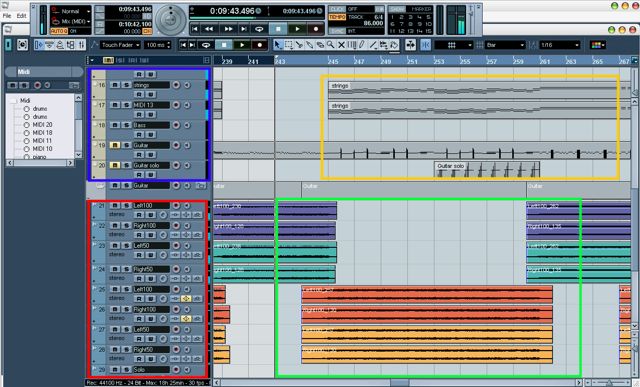
Red - list of audio tracks
Blue - list of midi tracks
Yellow - midi parts
Green - audio parts
We also need the so-called VST (Virtual Studio Technology) plugins and instruments (VSTi).
VST - These are separate programs that connect to the host. Plugins process sound (separate audio tracks, groups of tracks or the whole track together - this is essentially an effect), but instruments - impose their own sets of samples (sounds) on a registered MIDI track (in fact, this is a software synthesizer).
A huge number of VST plugins and tools for every taste can be found on torrents.
They are connected very simply:

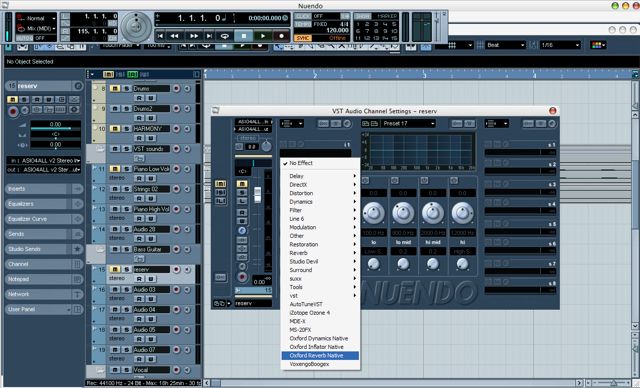
I’ll give an example of the appearance of several different VST tools:
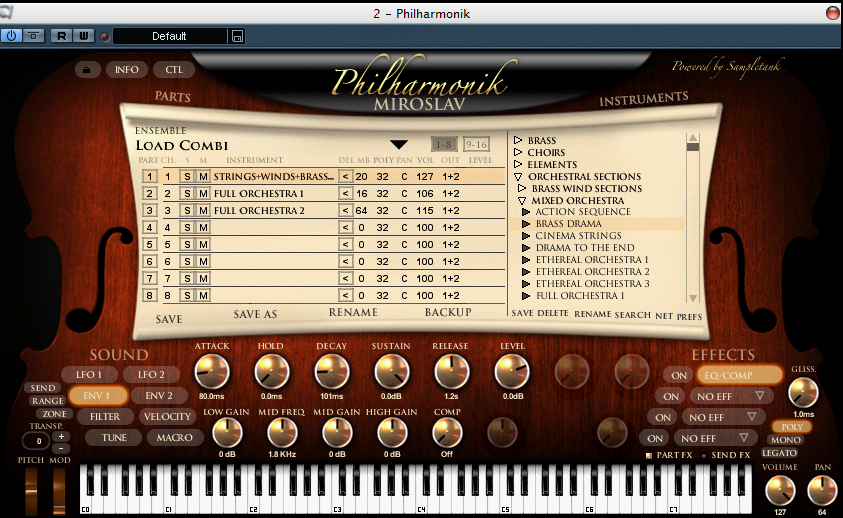

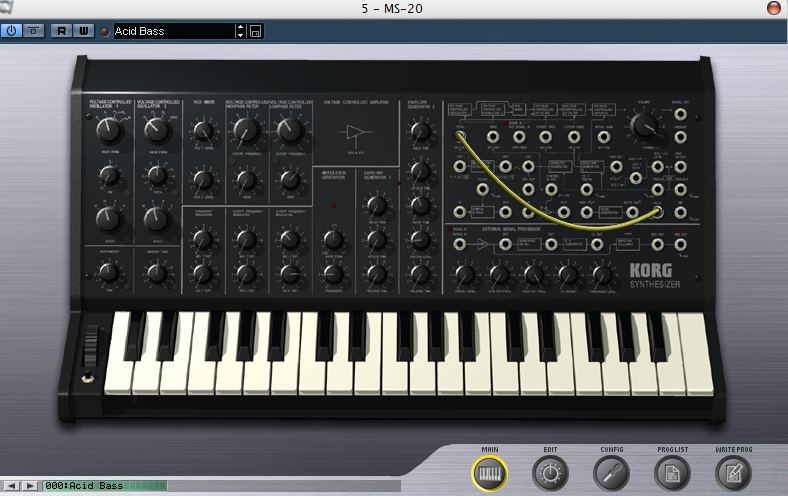
First of all, I would like to talk about the most important, from my point of view, music technology, which directly or indirectly underlies most musical compositions, regardless of style or orientation. This, without exaggeration, is the most frequently used and convenient technology, but first things first.
What is midi (Musical Instrument Digital Interface) and why is it so wonderful? Midi is a music protocol for transmitting and recording data. If it is easier to say, this is a technology that records at every moment in time a NOTU played, its VOLUME (velocity) and DURATION (in fact, there are a number of parameters, but at this stage they are not important). That is, this is some kind of control signal that indicates which note and with what volume it is necessary to play.
Why is it so good? Firstly - this is a very convenient way to record (note-up :)) parties. Secondly, the received signal can be processed as you like: apply any sound or sample to it. Thus, we can imitate any instrument, it all depends on the quality of the sample that will play this or that note.
The simplest example of using MIDI technology is monophonic and polyphonic mobile phones. The melodies in them are recorded with notes and loudness, and any selected instrument plays them (in monophonic phones there is only one instrument (sample): “piiiiii”, there can be many of them in polyphonic ones). What you hear in the columns when you run the midi file (*. Mid) on the computer is Microsoft’s standard General Midi Bank and many people think that midi ends there (sometimes the term “midi sound” is used - it means artificial, plastic and unnatural). However, a correctly “typed” part in midi (with realistic dynamics - loudness of notes, such as they would be when playing a real instrument) and good samples (which often take more than a dozen gigabytes) can give results, weak or not distinguishable from a well-recorded “live” instrument. This makes it possible, in the absence of a real piano / violin / saxophone, to get a very similar, and often better quality sound than it could be recorded in conditions of limited material capabilities (not on a super-duper studio).
It is worth noting that some instruments (such as a guitar, some winds) are almost impossible to make sound realistic, because their sound is too enriched with the "nuances" of the game and complex tones.
It is impossible not to say that most synthesizers also work on Midi technology or similar to it, reading the note and the force of pressing a key and generating the necessary sound for this note.
The part written in midi looks something like this:
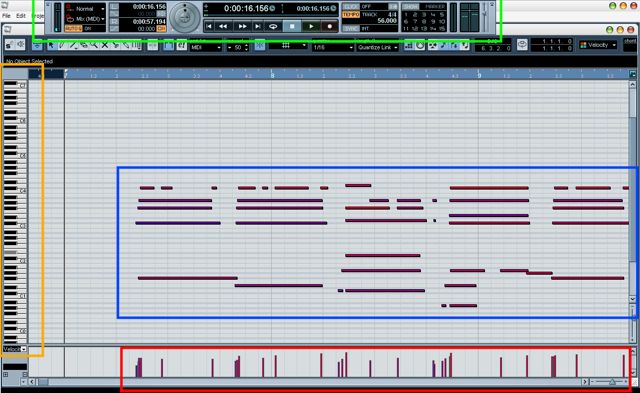
Yellow - The so-called PianoRoll - shows which note is played
Blue - The notes themselves, their duration and volume (redder - louder)
Red - The volume of the notes, each note with its own “column” velocity
Green - Control panel in the editor
The drum part is also registered with the help of MIDI technology, where each note corresponds to a beat on one of the drums / cymbals.
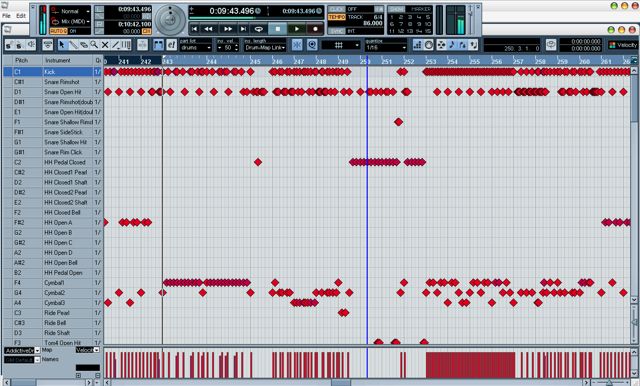
The MIDI part shown above using different instruments:
Acoustic piano: dump.ru/file/4946866
Bells: dump.ru/file/ 4946869
Rock organ: dump.ru/file/4946874
The above part of the midi drums separately and in the mix:
In the mix: dump.ru/file/4946883
Separately: dump.ru/file/4946877
Recording of any song consists of 3 main stages: accumulation, mixing and mastering.
- Accumulation - actually recording all the instruments (if they are "live" - then recording, if this is midi - then registering a part, selecting samples). Very often, the sound of the instrument during the accumulation and the sound that is obtained in the finished song are very different from each other due to subsequent processing, however, many sound engineers believe that the accumulation process is the most important and that it is on it that you need to achieve the necessary timbres of sound of each instrument.
- Mixing is mixing all the received tracks, adjusting the volume and frequency balances (equalization). This is truly the most creative and responsible stage, because it is on it that the sound of the whole composition is born, the general sound and the concept of the song are stuck together. At this stage, it is necessary to “make friends” with the guitar and bass, bass with drums and track, so that everything is audible and nothing “climbs” and does not “hide”.
-Mastering is the final stage at which the already mixed track is processed. The main goal of this stage is to make the resulting track sound equally good on any equipment - from professional to sven for UAH 25. However, often at this stage the track is given a more “compressed” or, conversely, more “airy” sound. There are many options for mastering - starting from expensive "master studios" and individual master engineers, ending with simple software processing of the resulting track. I use a special vst plugin - Izotope Ozone 4, which is connected as an effect to the so-called master bus (the bus is the channel through which the audio stream flows: there may be a bass guitar, guitar, vocals, etc. bus; master bus Is a common bus which is the sound stream of the entire mixed signal) - after which the desired preset is selected and settings are selected. This is convenient enough, since you can always turn it on / off to check if some instrument disappears in the mix after mastering, and for this you do not need to export the track and tinker in some other program:
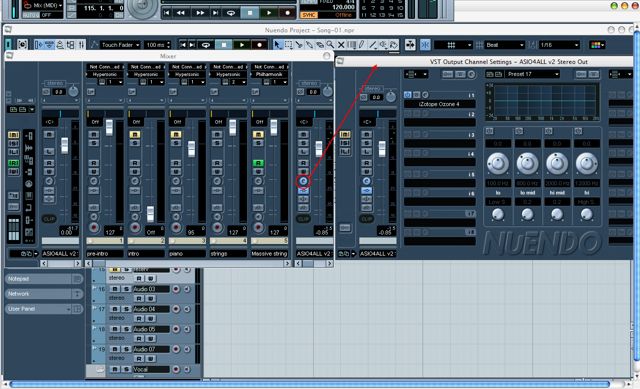

It is competent mastering that gives the track “firmness” and sound quality.
An example of a mix without mastering: dump.ru/file/4946886
An example of a mix with mastering: dump.ru/file/4946950
I hope you were interested!
Rock music is the music of life for very, very many people, it is music that carries the strongest energy in itself: from dark and dark to pathetically sublime, and everyone can find in it something for themselves. The refined beauty of rock ballads and the incredible drive of the "fighters" has been blowing the brain for a huge number of people for about 50 years. But we will not go deep into history, we will not try to prove who, after all, was the first rocker: the Beatles or Black Sabbath - let’s leave it to musicologists. Also, we will not try to differentiate it into styles, saying “this is fig pop music, and this is labor”, because, in my opinion, MUSIC cannot be enclosed in any framework. The purpose of this article is somewhat different - I want to try to shed light on what rock music is from the inside. The fact that for most eyes is hidden, and that excites many: “how did he do it?”, "What is it sticking out?" - that distinguishes between the listener and the musician. I want to try to shed light on those things on which rock music is mostly based: instruments, game techniques, technological side of the issue, but I want to make it as simple and clear as possible. This is exactly what I lacked at the time and, I hope, will become interesting and entertaining for you. I will also try to give a short excursion into the art of sound recording and how to make a ROCK at home :). It will become interesting and entertaining for you. I will also try to give a short excursion into the art of sound recording and how to make a ROCK at home :). It will become interesting and entertaining for you. I will also try to give a short excursion into the art of sound recording and how to make a ROCK at home :).
I ask you to forgive me in advance for some bias, bias and lack of education on some issues - I am only an amateur and not a professional, except that music is an art that always has at least 2 different points of view.
Licensed cracked software
A few words must be said about the software that is used for sound recording and will be necessary to create a song.
First of all, this is the host program (host) - the main editor in which all the work (recording / editing / creating) on audio and MIDI tracks takes place. Usually they have a huge number of features, various spinning twirls, flexible settings and other crap. In addition, they cost a lot of money (some cost up to 4-5 thousand evergreens), which makes up a considerable share of the cost of all equipment in a professional (legal) studio. But, not forgetting where we live - this does not really concern us :). Among the most common and professional hosts are Nuendo, Cubase, Ableton Live, Logic (for Mac), Sonar. Of the more amateur and "friendly" - Fruity Loops. Personally, I prefer Nuendo, as it is very ergonomic, comfortable and has a pretty solid base of built-in tools.
The working window in Nuendo looks something like this:

Red - list of audio tracks
Blue - list of midi tracks
Yellow - midi parts
Green - audio parts
We also need the so-called VST (Virtual Studio Technology) plugins and instruments (VSTi).
VST - These are separate programs that connect to the host. Plugins process sound (separate audio tracks, groups of tracks or the whole track together - this is essentially an effect), but instruments - impose their own sets of samples (sounds) on a registered MIDI track (in fact, this is a software synthesizer).
A huge number of VST plugins and tools for every taste can be found on torrents.
They are connected very simply:
Tool

the effect

I’ll give an example of the appearance of several different VST tools:
Miroslav Philarmonik (Symphony Orchestra)

Addictive Drums (acoustic drums)

MS-20 (Korg analog synthesizer emulator)

Midi - salvation for the musician
First of all, I would like to talk about the most important, from my point of view, music technology, which directly or indirectly underlies most musical compositions, regardless of style or orientation. This, without exaggeration, is the most frequently used and convenient technology, but first things first.
What is midi (Musical Instrument Digital Interface) and why is it so wonderful? Midi is a music protocol for transmitting and recording data. If it is easier to say, this is a technology that records at every moment in time a NOTU played, its VOLUME (velocity) and DURATION (in fact, there are a number of parameters, but at this stage they are not important). That is, this is some kind of control signal that indicates which note and with what volume it is necessary to play.
Why is it so good? Firstly - this is a very convenient way to record (note-up :)) parties. Secondly, the received signal can be processed as you like: apply any sound or sample to it. Thus, we can imitate any instrument, it all depends on the quality of the sample that will play this or that note.
The simplest example of using MIDI technology is monophonic and polyphonic mobile phones. The melodies in them are recorded with notes and loudness, and any selected instrument plays them (in monophonic phones there is only one instrument (sample): “piiiiii”, there can be many of them in polyphonic ones). What you hear in the columns when you run the midi file (*. Mid) on the computer is Microsoft’s standard General Midi Bank and many people think that midi ends there (sometimes the term “midi sound” is used - it means artificial, plastic and unnatural). However, a correctly “typed” part in midi (with realistic dynamics - loudness of notes, such as they would be when playing a real instrument) and good samples (which often take more than a dozen gigabytes) can give results, weak or not distinguishable from a well-recorded “live” instrument. This makes it possible, in the absence of a real piano / violin / saxophone, to get a very similar, and often better quality sound than it could be recorded in conditions of limited material capabilities (not on a super-duper studio).
It is worth noting that some instruments (such as a guitar, some winds) are almost impossible to make sound realistic, because their sound is too enriched with the "nuances" of the game and complex tones.
It is impossible not to say that most synthesizers also work on Midi technology or similar to it, reading the note and the force of pressing a key and generating the necessary sound for this note.
The part written in midi looks something like this:

Yellow - The so-called PianoRoll - shows which note is played
Blue - The notes themselves, their duration and volume (redder - louder)
Red - The volume of the notes, each note with its own “column” velocity
Green - Control panel in the editor
The drum part is also registered with the help of MIDI technology, where each note corresponds to a beat on one of the drums / cymbals.

The MIDI part shown above using different instruments:
Acoustic piano: dump.ru/file/4946866
Bells: dump.ru/file/ 4946869
Rock organ: dump.ru/file/4946874
The above part of the midi drums separately and in the mix:
In the mix: dump.ru/file/4946883
Separately: dump.ru/file/4946877
Stages of creation
Recording of any song consists of 3 main stages: accumulation, mixing and mastering.
- Accumulation - actually recording all the instruments (if they are "live" - then recording, if this is midi - then registering a part, selecting samples). Very often, the sound of the instrument during the accumulation and the sound that is obtained in the finished song are very different from each other due to subsequent processing, however, many sound engineers believe that the accumulation process is the most important and that it is on it that you need to achieve the necessary timbres of sound of each instrument.
- Mixing is mixing all the received tracks, adjusting the volume and frequency balances (equalization). This is truly the most creative and responsible stage, because it is on it that the sound of the whole composition is born, the general sound and the concept of the song are stuck together. At this stage, it is necessary to “make friends” with the guitar and bass, bass with drums and track, so that everything is audible and nothing “climbs” and does not “hide”.
-Mastering is the final stage at which the already mixed track is processed. The main goal of this stage is to make the resulting track sound equally good on any equipment - from professional to sven for UAH 25. However, often at this stage the track is given a more “compressed” or, conversely, more “airy” sound. There are many options for mastering - starting from expensive "master studios" and individual master engineers, ending with simple software processing of the resulting track. I use a special vst plugin - Izotope Ozone 4, which is connected as an effect to the so-called master bus (the bus is the channel through which the audio stream flows: there may be a bass guitar, guitar, vocals, etc. bus; master bus Is a common bus which is the sound stream of the entire mixed signal) - after which the desired preset is selected and settings are selected. This is convenient enough, since you can always turn it on / off to check if some instrument disappears in the mix after mastering, and for this you do not need to export the track and tinker in some other program:
Connecting VST Izotope Ozone4:

VST Izotope Ozone4 Menu:

It is competent mastering that gives the track “firmness” and sound quality.
An example of a mix without mastering: dump.ru/file/4946886
An example of a mix with mastering: dump.ru/file/4946950
I hope you were interested!
